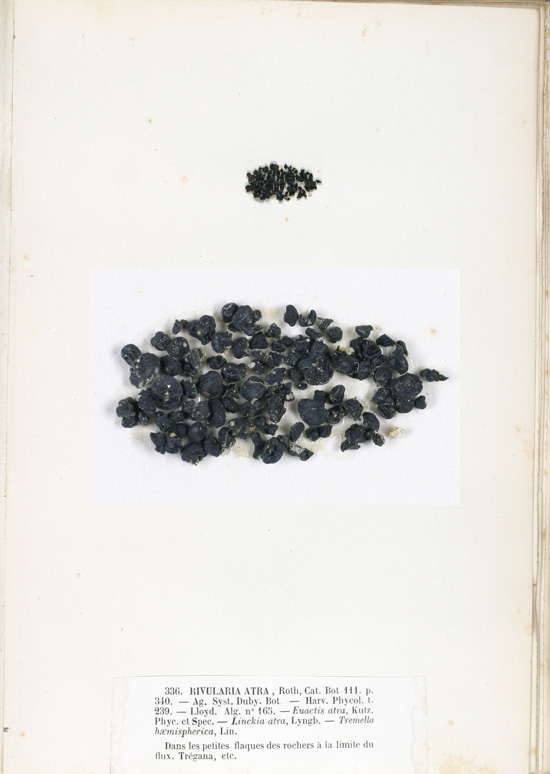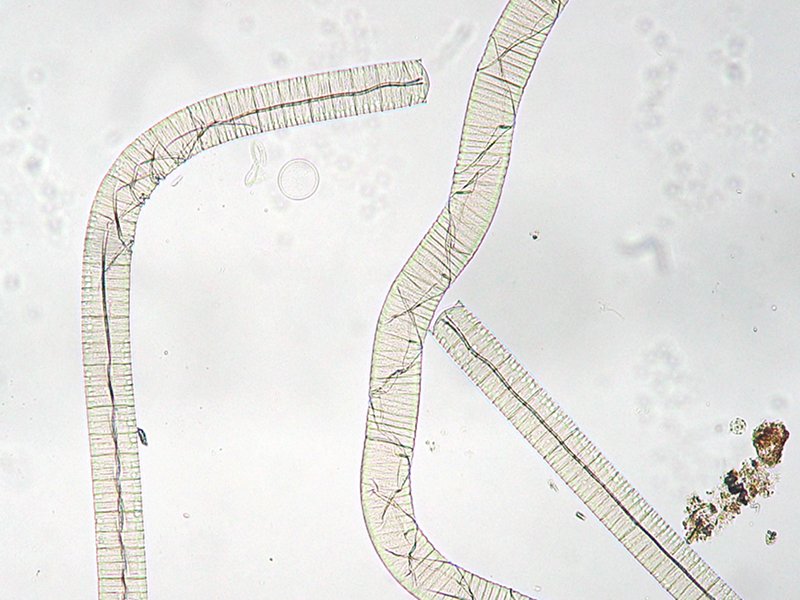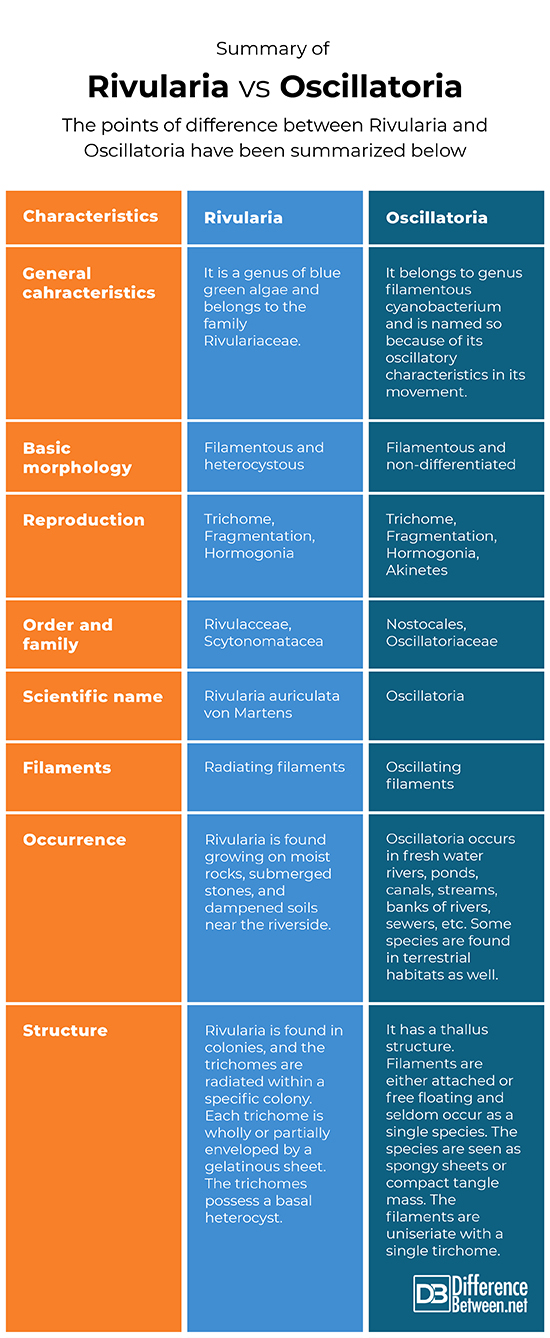Difference between Rivularia and Oscillatoria
What is Rivularia and Oscillatoria?
Both are types of blue-green algae. However, Rivularia belongs to family Rivulariaceae and Oscillatoria belongs to family Oscillatoriaceae
What is Rivularia?
Rivularia is a genus of Bacteria belonging to the family Rivulariaceae. It is found growing on moist rocks, submerged stones, and damp soils close to the riverside. Other typical habitats include rivers, streams and lakes. It is usually found in colonies that are densely united. It possesses heteropolar cyanobacterial filaments which have heterocytes at their bases. Akinetes are absent in Rivularia. False branching is lacking as well. There are no organelles present in the cells of Rivularia. Filaments disintegrate by developing an intercalary heterocyte which separates form the parent filament and develops parallel to it within that colony. Trichomes show radial arrangement within a colony and each trichome is partially or wholly enveloped by a gelatinous sheet. Reproduction in Rivularia takes place by the formation of hormogones. These are formed at the distal end of each filament.
Colonies is Rivularia are hemispherical in shape and the filaments are parallelly arranged forming irregular, flat or hemispherical layers. The colonies are lime encrusted or gelatinous, either few millimetres thick or can be seen through microscope, clinging at the base to substrata. Cells are cylindrical or barrel shaped and without aerotopes.
Filaments show pseudo branching, are heteropolar, widening at the base with heterocysts, and narrowing hair like narrowing towards the ends.
What is Oscillatoria?
Oscillatoria is a genus of filamentous blue-green algae occurring singly or in tangled mats in freshwater environments that includes hot springs as well. This filamentous cyanobacterium is unbranched and named after its oscillatory movements. The blue green algae have derived its name from its very slow and rhythmic oscillatory motions which is caused by the secretion of mucilage which forces the filament away from the course of excretion. Reproduction in Oscillatoria happens by fragmentation in which dead separation disks (concave cells) disintegrate sections of the filaments (process called as hormogonia). Every single filament of Oscillatoria consists of a trichome which comprises of a row of cells. The tip of the trichome is able to oscillate like a pendulum. The hormogonia is able to grow into a new, longer filament. Disintegration of filaments occurs where the dead cells called necridia are found. Filaments occurring in colonies slide back and forth again one another till the time the entire mass is reoriented to the light source.
Difference between Rivularia and Oscillatoria
-
Primary characteristics
Rivularia
Rivularia is a genus of blue-green algae belonging to the family Rivulariaceae. The filaments are arranged radially and the branching is false. Filaments are heteropolar, differentiated into apical and basal parts, and joined parallelly into firm. The trichomes possess a basal heterocyst.
Oscillatoria
Oscillatoria is a genus of filamentous blue-green algae with long un-branching filamentous morphology. It is an important blue-green alga as it plays an important role in photosynthetic activities. It is green in colour because it contains chlorophyll. The genus is named after its oscillating movements. Filaments present in the genus slide back and forth to secure the position of the colony towards a light energy source. Oscillatoria is motile and uses microfibrils for its movement.
-
Reproduction
Rivularia
Reproduction in Rivularia takes place by the formation of hormogones. These are formed at the distal end of each filament. There is no reproduction through Akinetes in this Algae.
Oscillatoria
Oscillatoria reproduces only through vegetative methods.
-
Structure
Rivularia
Rivularia is mostly found in colonies. Each filament in the body of Rivularia is whip-like and possesses a single trichome which have a marked taper and a basal heterocyst supporting their cycle of growth.
Oscillatoria
The body of Oscillatoria comprises of single row of cells. These rows of cells lead to the formation of trichomes which are termed as unbranched filaments. These filaments are covered by a very thin mucilaginous layer.
Each cell in Oscillatoria is has a cell wall which has 3 layers. The inner layer of the cell – thin cellular layer, medium layer – pectic layer, outer layer – mucilage layer
-
Occurrence
Rivularia
Rivularia grows on submerged stones, damp soils and moist rocks.
Oscillatoria
Oscillatoria occurs in freshwaters, marine environment, planktons, benthos. In highly organic habitats like the salt marshes, colourless strains of Oscillatoria can be seen. A few species are found in terrestrial habitats as well.
-
Taxonomic Hierarchy
Rivularia
Kingdom – Bacteria Cavalier-Smith, 2002
Subkingdom – Negibacteria
Class- Cyanophyceae
Phylum – Cyanobacteria
Order – Nostocales
Family – Rivulariaceae; Frank, 1886
Genus – Rivularia; C. Agardh, 1886
Oscillatoria
Kingdom – Bacteria
Phylum – Cyanobacteria
Class- Cyanophyceae
Order – Oscillatoriales
Family – Oscillatoriaceae
Genus: Oscillatoria; Vaucher ex Gomont, 1822
-
Filaments
Rivularia
In Rivularia, the filaments are radiating.
Oscillatoria
In Oscillatoria, the filaments are oscillating
Summary of Rivularia Vs. Oscillatoria
The points of difference between Rivularia and Oscillatoria have been summarized below: Chart for Rivularia Vs. Oscillatoria
- Difference Between Global Warming and Greenhouse Effect - May 18, 2024
- Difference Between Vaccination and Immunization - March 3, 2024
- Difference Between Selective Mutism and Autism - February 25, 2024
Search DifferenceBetween.net :
Leave a Response
References :
[0]Image credit: https://gl.wikipedia.org/wiki/Oscillatoria#/media/File:Oscillatoria_princeps.jpeg
[1]Image credit: https://commons.wikimedia.org/wiki/File:Rivularia_atra_Crouan.jpg
[2]Bakiyaraj, R., Baskaran, L., & Senthilkumar, T. (2014). Isolation and identification of cynobacteria (Oscillatoria pseudogeminata G. schmid) from marine water and its potential on remediation of pesticide. International journal of current microbiology and applied sciences, 3(3), 256-267.
[3]Berrendero, E., Perona, E., & Mateo, P. (2008). Genetic and morphological characterization of Rivularia and Calothrix (Nostocales, Cyanobacteria) from running water. International Journal of Systematic and Evolutionary Microbiology, 58(2), 447-460.
[4]Livingstone, D., & Whitton, B. A. (1984). Water chemistry and phosphatase activity of the blue-green alga Rivularia in Upper Teesdale streams. The Journal of Ecology, 405-421.
[5]Sivonen, K., Niemelä, S. I., Niemi, R. M., Lepistö, L., Luoma, T. H., & Räsänen, L. A. (1990). Toxic cyanobacteria (blue-green algae) in Finnish fresh and coastal waters. Hydrobiologia, 190(3), 267-275.



